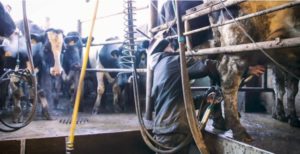 One of the key themes at this year’s National Dairy Conference was the topic of making Irish dairy farms better workplaces for employees, as labour becomes an increasingly important issue.
One of the key themes at this year’s National Dairy Conference was the topic of making Irish dairy farms better workplaces for employees, as labour becomes an increasingly important issue.
The conference, organised by Teagasc, covered the topic in one of six workshops which took place earlier today (Tuesday, November 27) in Cork.
With an additional 300,000 dairy cows in the country since 2010, more and more dairy farmers are now employing either full or part-time workers to manage the increased herd sizes.
Employees
At the same time, with labour availability reducing to 5.4% in 2018 with the upturn in the economy, from 15% in 2010, there is now increased competition for workers.
This has meant that attracting and retaining employees is crucial for the success of Irish dairy farmers and so it is essential Irish farms are attractive places to work, according to Teagasc.
At today’s workshop, Teagasc advisors Mark O’Sullivan and Paidi Kelly mediated a discussion on what makes dairy farms more attractive work places for employees, featuring presentations from dairy farmer and employer Diarmuid Hegarty and farm worker Cormac Desmond.
It was noted that two key questions which dairy farmers must ask themselves are: “What is it like for someone else to work on my farm?” and “What am I like to work for?”
Kelly noted that employees for dairy farms want a variety of things from their work: fair reward for their efforts; a nice place to work; work they enjoy doing; a nice person to work for; and a job that fits in with their personal lives.
Hegarty explained his own situation as a dairy farmer, noting that he had one farm assistant and took on a student, either second or third level, in the spring and for relief milking later in the year. He noted that effective communication is very important for good relationships with workers.
Meanwhile, Desmond outlined his experience working for local dairy farmers both as an agricultural college student on placement and as a full-time worker.
He explained that, as a dairy employee, he appreciated good structure and organisation, as well as good routines and knowing what his schedule was – while good facilities made working that bit easier.
Regarding what he looks for in an employer, Desmond explained that he seeks:
- A good introduction, not expecting too much too soon;
- An employer willing to teach things such as grass measuring;
- An employer who is well organised with rosters and the flexibility to take hours or days off when needed;
- A good relationship, understanding that people have lives outside of work;
- Having one employer, not two; and
- Acknowledgement and appreciation – even just saying “well done” on occasion.
In a farm as a workplace, aspects earmarked as benefits included: an organised working day with set finishing times; a well-planned working day with a clear outline of jobs to be done; good facilities working well; and some responsibility, such as a specific job like looking after calves.
Farming workplace
Having a farm that is a good workplace is crucial not just for employees, but also the farm family and the farmer himself or herself, according to Teagasc guidelines.
A good farm workplace is a safe place to work, well organised, and people have the resources they need to efficiently complete all tasks.
There are many aspects of providing a good farm workplace including:
- Being a good employer – ensuring that the farm follows best practice in recruiting and managing employees including meeting all legal requirements;
- Promoting good communication;
- Providing adequate farm facilities in good working order – e.g. milking parlour, cow and calf accommodation; and
- Setting the farm up for success – farm maps, whiteboards, standard operating procedures.
Summing things up in the workshop, Kelly said that making farms better workplaces has a number of benefits.
As well as attracting and retaining employees, such a move will help attract the next generation and make farming more enjoyable for farmers themselves.
Article by Sylvester Phelan, Agriland.
